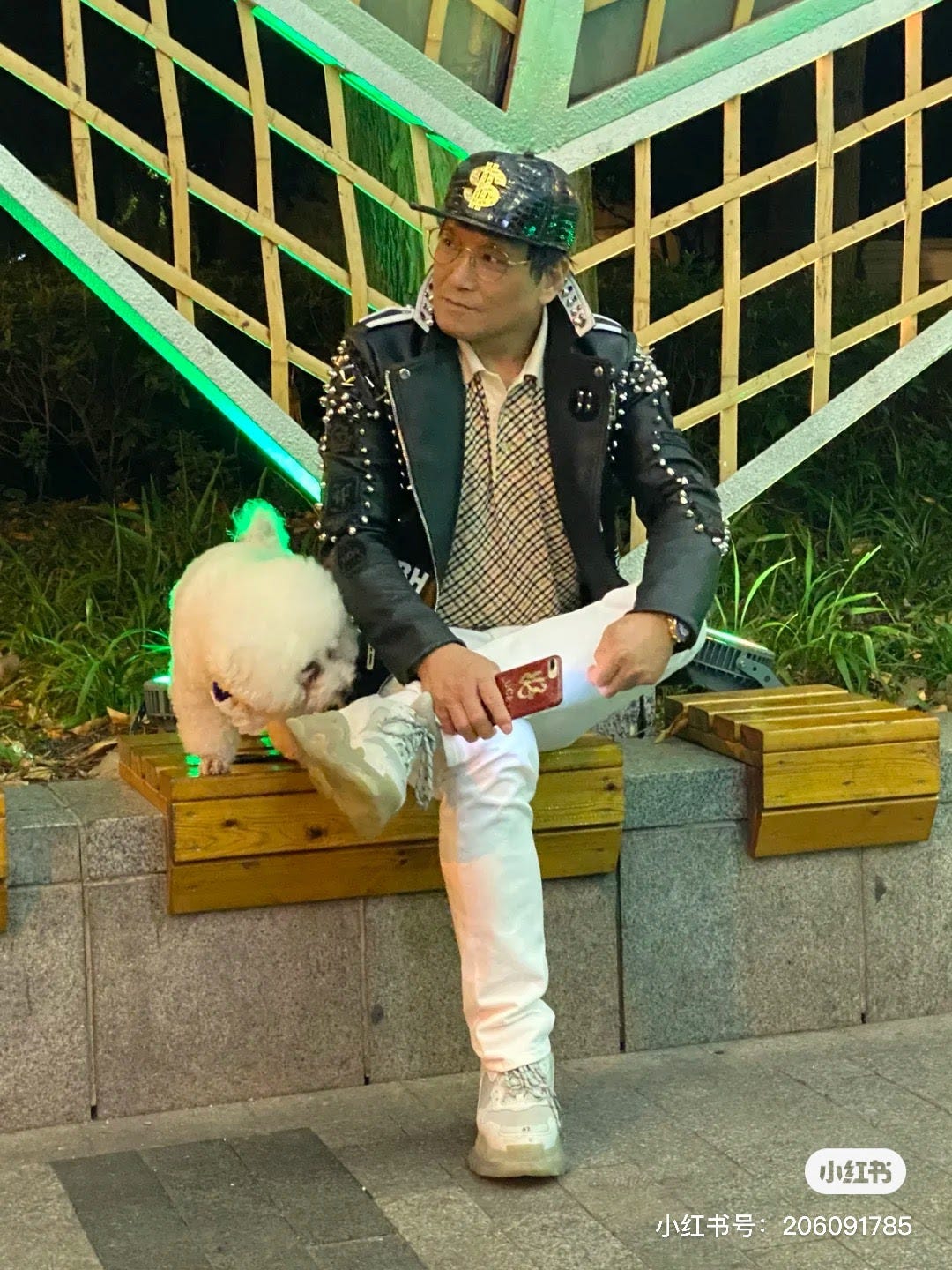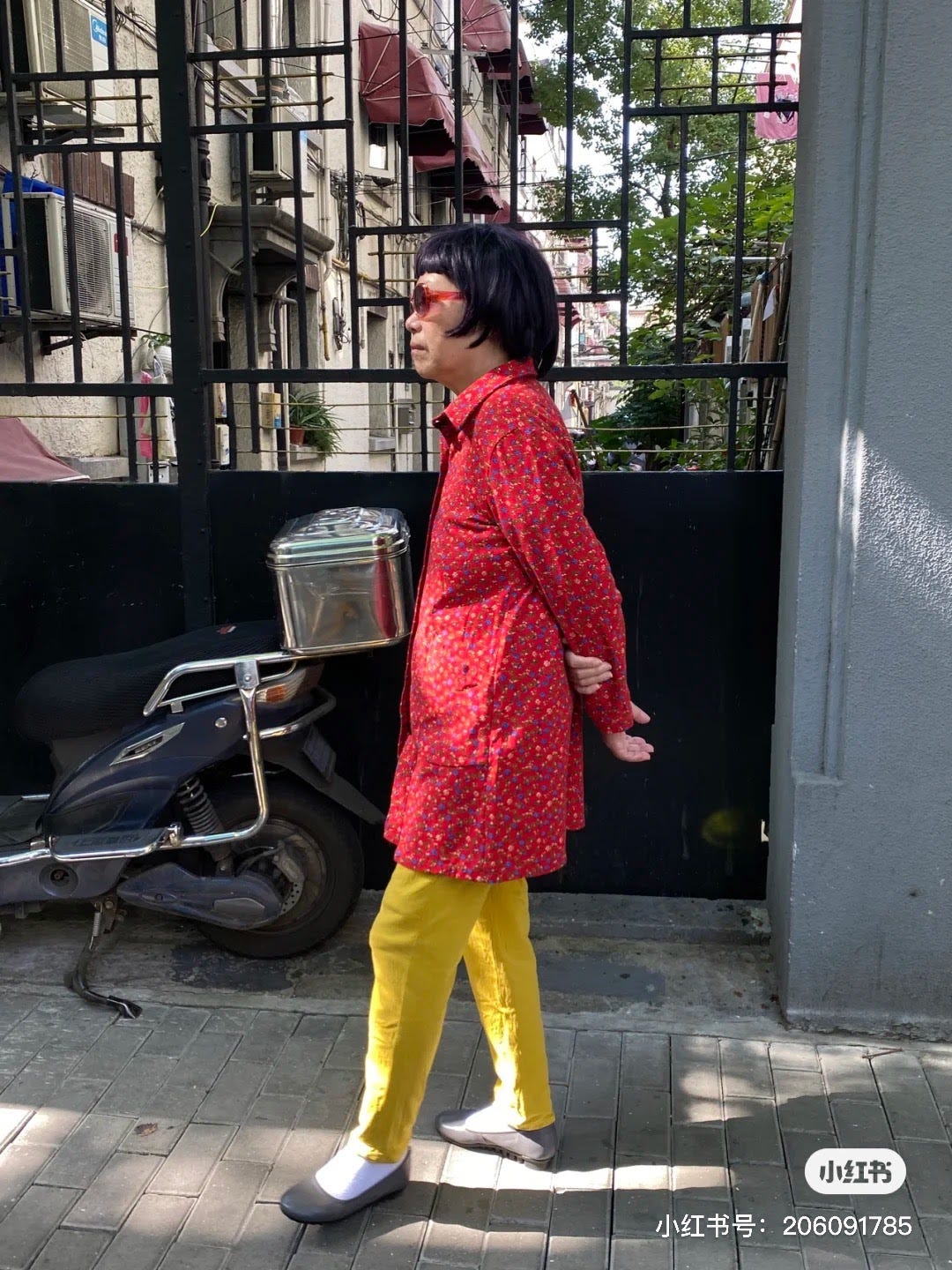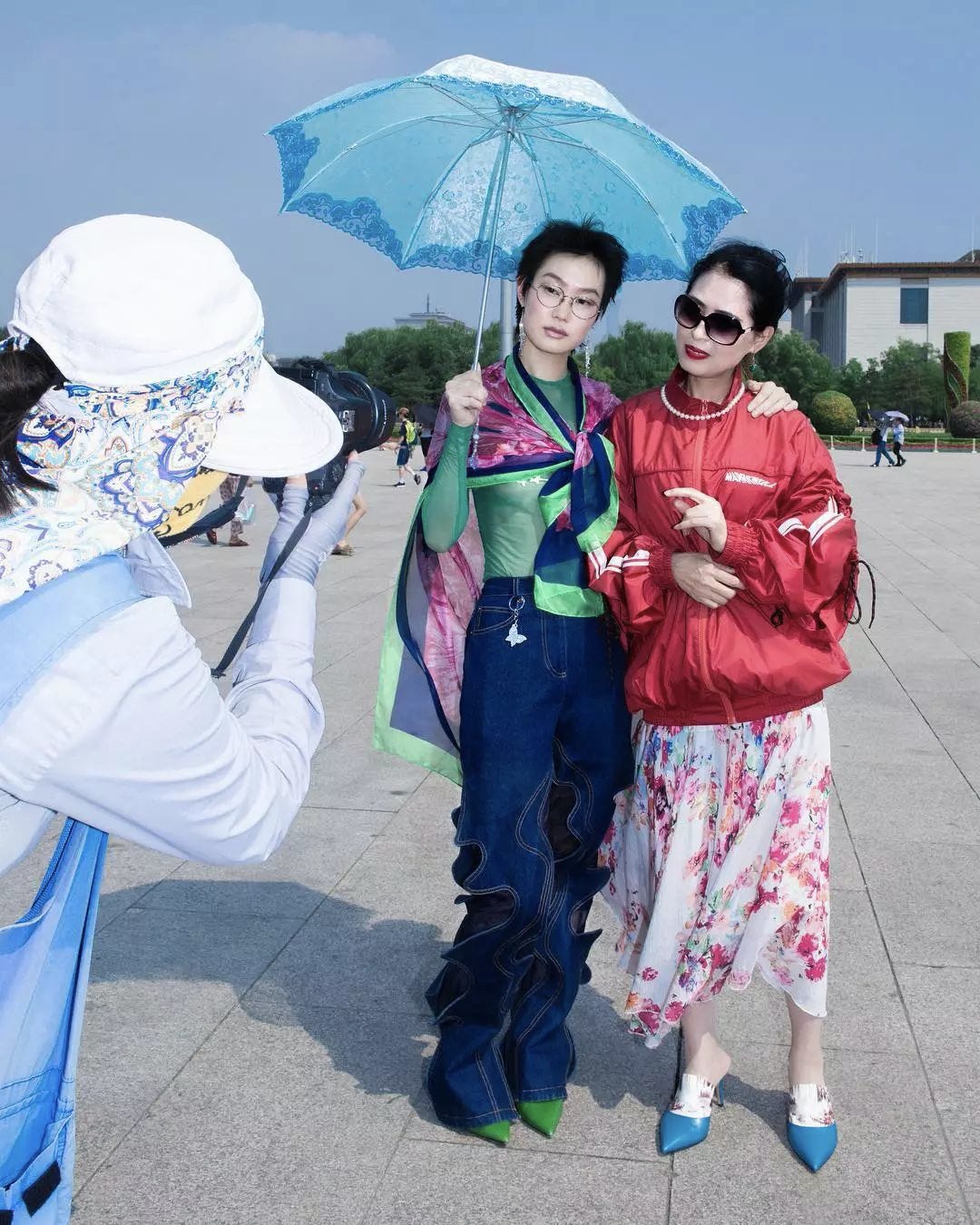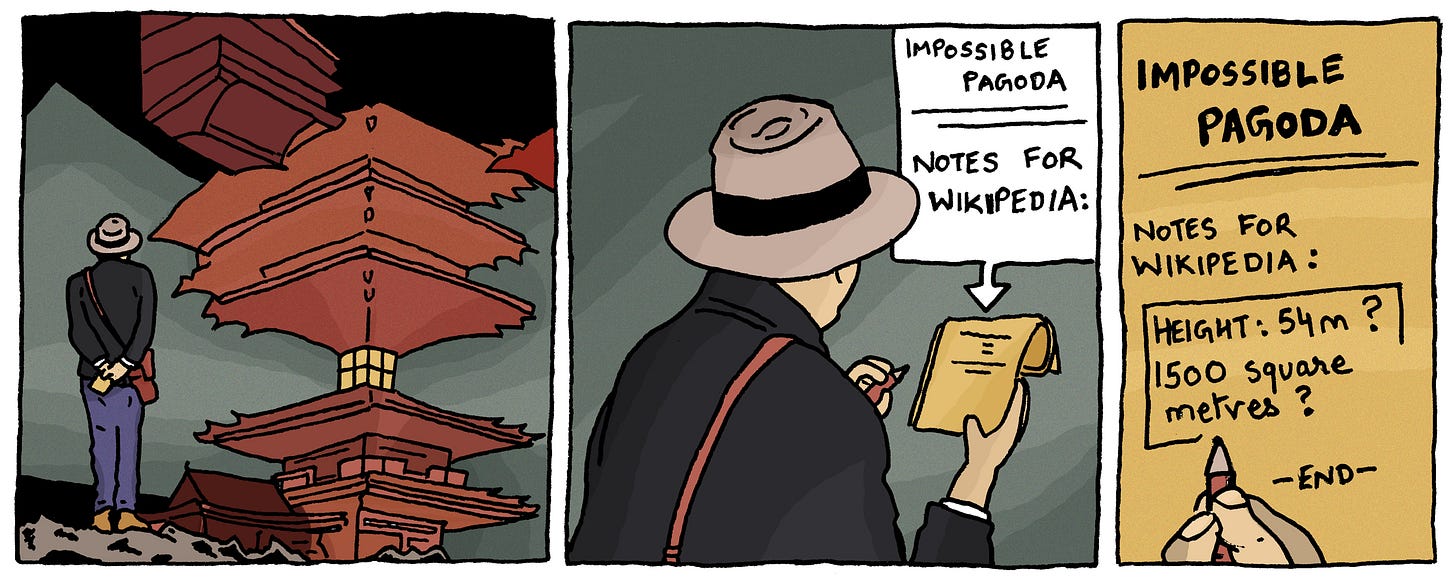S01 Episode 7: The Little Red Lookbook / Wikipedia Weirdness
Recreational Vehicle Capital of Shandong + The Horseshoe Theory of Chinese Fashion + “B̌̃eĕ̐̃̀ ͉ͤMy͊̓̇͊st͂͒ͬ̒e͍̦̯̪͍r̗͓͈͇̽͛̏ͦỹ͎̤͆”
In the house this week: Xuandi, Joshua, Jen, Tianyu, Yan, Jaime, Ting, Yi-Ling, Krish, and Henry.
Krish: Welcome to Episode 7. Our two stories this week are about magical realism. There are square-dancing meme cat hoodies. There’s a giant orb over a mountain town. There’s a bee mystery.
First, Xuandi looks at how “the bricolage of senior-citizen fashion subverts the platform logic of influencer marketing.” Or, put another way, how SpongeBob slippers can be a symbol of the revolution.
Then, Joshua digs into the Wikipedia pages for Chinese towns (it’s his hobby). Why do they veer into obsessive hand-wringing over the square footage of tourist sites? Why are they so odd, and what does that say about China in the global imagination?
Together, they’re a fascinating dive into how the internet produces the “real” in China. How does something read as “true,” and what are the tells? Senior fashion is an anarchic moodboard of urban visual culture. China on Wikipedia is a stiff simulacrum of local diversity, stripped of all relatable weirdness. One feels more real than the fake. The other is more fake than the real.
Tianyu: A reminder that we are now open for pitches—we’re looking for both writers and illustrators, so hit us up with anything that’s on your mind! We’ve got 3 more issues planned in Season 1, with a few special surprises dropping over the next month.
Krish: Let’s start with Surprisingly Ripped Jeans.
The Magical Realism of SpongeBob Slippers
By Xuandi Wang
(All images used with photographer’s permission)
Xuandi: I was killing time on Xiaohongshu (小红书, also known as RED) when a photo caught me off guard.
A silver-haired man in an outsized blazer jacket and garish ripped jeans, nonchalantly walking down a street with a pink grocery bag in his hands. It stood out among all the filtered and edited photos on this influencer-heavy platform. There was an effortless charm to it—a perfect balance between humble wardrobe staple and ostentatious swagger.
The photo was on an account called Senior Fashion Hub (老年时装俱乐部), operated by Qin Xiao (秦霄), a fashion photographer based in Shanghai. Originally from Shanxi, Qin launched his career as a wedding photographer, but later switched to work in commercials. Being immersed in the fashion industry, he was tired of how, as he told me, “the youth often relentlessly chase the latest fashion trends.” So instead, he turned his lens to capture seniors on the streets.
Entranced by the way seniors dress in Shanghai, Qin began to snap their photos in 2019, a hobby that later developed into a long-term project. The subjects of Senior Fashion Hub are mostly in their 60s and 70s. It has garnered an impressive following online, attracting more than 26,000 fans on RED and even surprising coverage from the state-affiliated Global Times.
A buzzy lifestyle-focused social media platform with over 300 million registered users, Xiaohongshu marries Instagram-like feeds with online storefronts. Catering to mostly fashion-forward young women, influencers on the platform often post highly edited outfit photos and direct them to purchase the products they back.
Krish: A VC-backed “Steal Her Look.”
Xuandi: But Senior Fashion Hub doesn’t have any commercial bent. The account has no purchase links or endorsement deals behind it.
Qin divides his work into two categories. The first is seniors who take their outfits seriously, and those efforts are often clearly visible. “I’ve sometimes spotted hand-made leather boots, or well-ironed pants, without any creases. Sometimes, the color palette is very harmonious. Even though there is nothing expensive, you can tell these seniors put some thought into their outfits.”
The second category, Qin’s favorite, is what he calls 野生, or the “wild” type—bedazzling mix-and-match, chaotic, without obeying any rules.
For instance, to add more color to her patchwork jacket, a lady in her 60s or 70s puts on a pair of SpongeBob slippers. A guy wears a meme-cat hoodie while dancing with his female friend at a park.
These combinations both puzzled and delighted me. I genuinely could not figure out if these seniors bought their clothes themselves or were just recycling whatever their family members threw away. Under one photo on Xiaohongshu, someone commented:
“Maybe this uncle just couldn’t find anything to wear offhand, so he put on the mink overcoat from his wife, sweatpants from his grandson, and hiking boots from his son.”
Some even went further and did some forensic analysis of these items of clothing. “The hat is given for free if you buy nutritional supplements. I often see seniors wearing it,” reads one comment. “When I was little, fashionable women in my hometown would wear this kind of vest. I was born in Zhejiang,” goes another.
In addition to the nostalgia those photos evoke, some followers genuinely appreciate these outfits and use them as daily inspiration. As fashion brands recycle bygone aesthetics, why not just borrow the look directly from the older generation? “This photo looks like it's directly from a Saint Laurent Paris walky,” reads one comment, under that first photo that caught my attention.
I am dazzled by these photos because they are so counter to a platform infiltrated by advertisements. On Xiaohongshu, influencers carefully develop their personas through staging and outfit choices on their photos. Get a college hoodie or a varsity jacket if you want to look like an Ivy-League student. Before going to a punk concert, remember to order some chains and necklaces on Taobao.
Their photos put forward cookie-cutter narratives about lifestyles and subcultures. As advertisements, they’re meant to replicate. They invite consumers to copy their looks, making them derivative and banal.
But the “wild” fashion of Senior Fashion Hub feels different. Instead of neat templates, they function more like assemblages. A “bricolage” of fashion rooted in the real world rather than in easy archetypes.
That auntie could be wearing a free hat scoured from a promotional event, a plastic bag used for grocery shopping, and a hoodie borrowed from her grandson. The lack of organization, or an underlying organizing principle, sparks something almost magical-realist. The messiness defies any efforts to name or categorize. It mesmerizes people like me with a tactility and sensation that cannot be easily summarized online.
“After 20 or 30 years,” Qin said. “These photos would be the best ones to encapsulate our time.”
Yan: This reminds me of “Fairy Tales,” a documentary by director Guo Rongfei. The film’s main character, Wang Shouying, is a woman from rural Shandong province with no professional background in fashion. Her designs, mostly using materials easily found in her village, are a mix and match of high fashion and “wild” fashion. When she posted photos of her work on Weibo, many of them shot in a messy, backlit storage space, people were quick to judge and mock her designs. As she gained traction and exhibited her work in a gallery in Shanghai, the audience, while wearing luxury brands and sipping champagne, were fascinated by its rawness. It says a lot about what fashion is and who gets to define it nowadays. And the joke is on us if we submit ourselves to brand names or approvals from fashion gatekeepers, and are unable to recognize the wild and effortless creativity among us.
Henry: As someone who’s told he dresses like a Chinese septuagenarian, I’d say that if there’s a horseshoe theory for Chinese fashion, its two metal tips are the country’s hip young clothing designers and its cheerfully slapdash seniors, who are united by this bricoleur’s sensibility—the latter “innocently,” the former with a blend of homage and parody. Take the relatively new boutique design studio Marrkknull, whose clothes appear in runways in London. (The model, in case you couldn’t tell, is the one on the left.)
I, too, marvel at how these old folks manage so effortlessly to achieve the stylistic dissonance that a PBR-drinking Wesleyan student might strive for—but then I remember that their fake Kumamon totes and Kenzo caps likely come from the same production line, where the sole operative similarity—a foreign logo—overshadows supposed differences in “branding,” which mean nothing to either the factory or the consumers. In which case, the clothes don’t clash at all—I’m the one who’s aesthetically unmoored.
Jaime: The fact that we don't accuse fashionable seniors of "selling out" "personal style" or "branding" for "wanghong" makes me wonder what rules apply to senior "street style" fashion—i.e. how aware are they of Qin's photography? Do they care? While it's really good content, does it become ethically blurry in any way in how these images get produced or in how we consume cute senior content that we enjoy partly because of the distance from our own "modernity?" And to Henry's point about the fashion horseshoe, it also becomes a kind of litmus test for people who either "get it" or don't.
Ting: Continuing Henry’s point—I feel like what puts the “cool” in “too-cool” (土酷) fashion is just ironic detachment, i.e. “you have to know the rules to break them”. But I’m also curious to know what these seniors actually think, not just about the consumption of their images, as Jaime noted, but their actual intention and process - what logic might we be imposing on them when we brand them as original, creative and unaware, especially as a counterpoint to modern consumerism that plagues “the public/the youth” but supposedly leaves them untouched? Where are we placing ourselves on this spectrum?
Yi-Ling: I’m reminded, by Jaime and Ting’s point, of Tumblr blogs that emerged a few years back called “Accidental Chinese Hipsters” that mostly featured the elderly, and their mish-mash, sponge-bob, unintentional bricolage fashion. In fact, a quick search on Google will yield a whole genre of that form of online content, like HuffPost’s “14 Chinatown Seniors with More Swag Than Anyone You Know.” The tone teeters on a delicate balance of admiration and paternalism towards the elderly, earnest fashion blog and irony-laden comedy. To me, the Xiaohongshu blog still lies on the former side of the balance, and the HuffPo article on the latter. But it’s a thin line.
Krish: Where Senior Fashion Hub’s photos may best encapsulate this time, the subject of our next story absolutely does not.
Joshua Dummer digs into a years-long obsession: the Wikipedia pages of smaller Chinese towns and cities. Who was responsible for them, and how did so many of them get so bizarre?
Where the magical realism of Senior Fashion Hub comes from a core of the real within the surreal, reading Wikipedia entries for Shandong towns conjures a sense of mystery from absence. The dry recitation of square footage, the omissions of flavour—they create this sense of dislocation and incompleteness. What fills this gap, as we’ve seen in many, many, many bad China news reports, is a sense that China isn’t a “real” place. We now know how dangerous that is.
[Note: The next story contains a 3-question quiz in the image captions. Read to the end for answers! Every multiple choice option is a real phrase from a Wikipedia article about a Chinese town or city.]
“Bee Mystery” [Citation Needed]
By Joshua Dummer
Joshua: If it’s longer than 50 words, you can almost guarantee the Wikipedia entry for nearly any Chinese county, district or small city is weird.
These articles, and sometimes even for pretty significant cities, veer off into non-sequiturs, blatant pro-hometown bias, wonky machine translations or just completely miss what would seem to be most important things about the region. They often violate nearly every rule Wikipedia sets.
Let’s take Hua County (滑县) in Henan as an example of missing the most important points. Hua County is home to about 1.2 million people, giving it a population just a bit smaller than Prague. Its Wikipedia page was the only place Google could find me any English information about it.
If anything, Hua County’s article on Baidu Baike, the Chinese web’s Wikipedia equivalent, is too in-depth. Across 12,000 characters, it offers you reams of statistics about grain output, canal maintenance, and vocational school graduations. It also tells you about its history, the number of eaves on its Tang Dynasty tower, its acclaimed roast chicken, and some of its famous progeny, including CPC General Secretary Zhao Ziyang.
The English Wikipedia article barely tops 300 words, as do the pages in most other languages. The only local color is the two-sentence “Hua County in the News” section, citing the South China Morning Post.
“On 10 September, 2009, the Basic People’s Court sentenced Wei Fazhao to death for his January drunk-driving killing of eight people and injuring of three. It was the first death penalty given to a drunk-driver anywhere in Henan.”
It’s pretty clear that this has been included just because it’s the only time Hua County has even been mentioned in an English news story.

Even in the case where these pages have more content, what is included is often not what you’d expect from an encyclopedia.
The article for the central Zhejiang county-level city of Yongkang (永康, population 750,000) spends a few sentences explaining that the county has 2,000 years of history, and that its name has changed a few times. Despite Yongkang existing for 100 generations, most of the article focuses on its hardware-manufacturing industry.
It explains that Yongkang is named the “Cradle of Hardware of China”, the “Hardware Capital of China”, the “Cup Capital of China,” the “Door Capital of China,” and the “Recreational Vehicle Capital of China.”
The page for Wuhan is pretty normal. But the page for its Caidian district (蔡甸, population 410,000) offers a list of contextless, one-line anecdotes. Once, millions of bees died for an unknown reason (section titled “Bee Mystery”). Once, there was a particularly grisly murder (“Crimes Against Humanity”). Local school children sometimes plant trees (“Tree planting”).



Joshua: This isn’t just because these are smaller places. Compare these odd, barely-there pages to that for say, Nikšić. It’s the second-largest city (population 56,000) in Europe’s 40th largest country, Montenegro. Its page has a nice picture, detailed history going back to the medieval period, its cultural and educational scene, its sports teams, transport links, historical demographics and economy. Even tiny places in English-speaking countries have decent pages on English Wikipedia. The 891 residents of La Conner, Washington, boasts a full page that includes how the town went from making the wild turkey the official town bird in 2005, to attempting to expel all turkeys in 2010.
Wenzhou, as a wealthy city with a particularly large diaspora, has a page more detailed than nearly any other third-tier city. But it’s a great example of hometown cheerleading—much of the detail is simply effusive praise for the nine million Wenzhounese and their ancestors. Their math ability is simply outstanding. Their business sense is unrivalled in China (“A popular common saying calls Wenzhounese the ‘Jews of the Orient’”). They’re really amazing at chess. Taiwan’s higher education and tech sector was created by the Wenzhounese. They basically invented whole branches of Chinese philosophy and now write the finest Chinese drama. The only reason their unique music isn’t appreciated worldwide is that it’s too complicated for outsiders to understand.
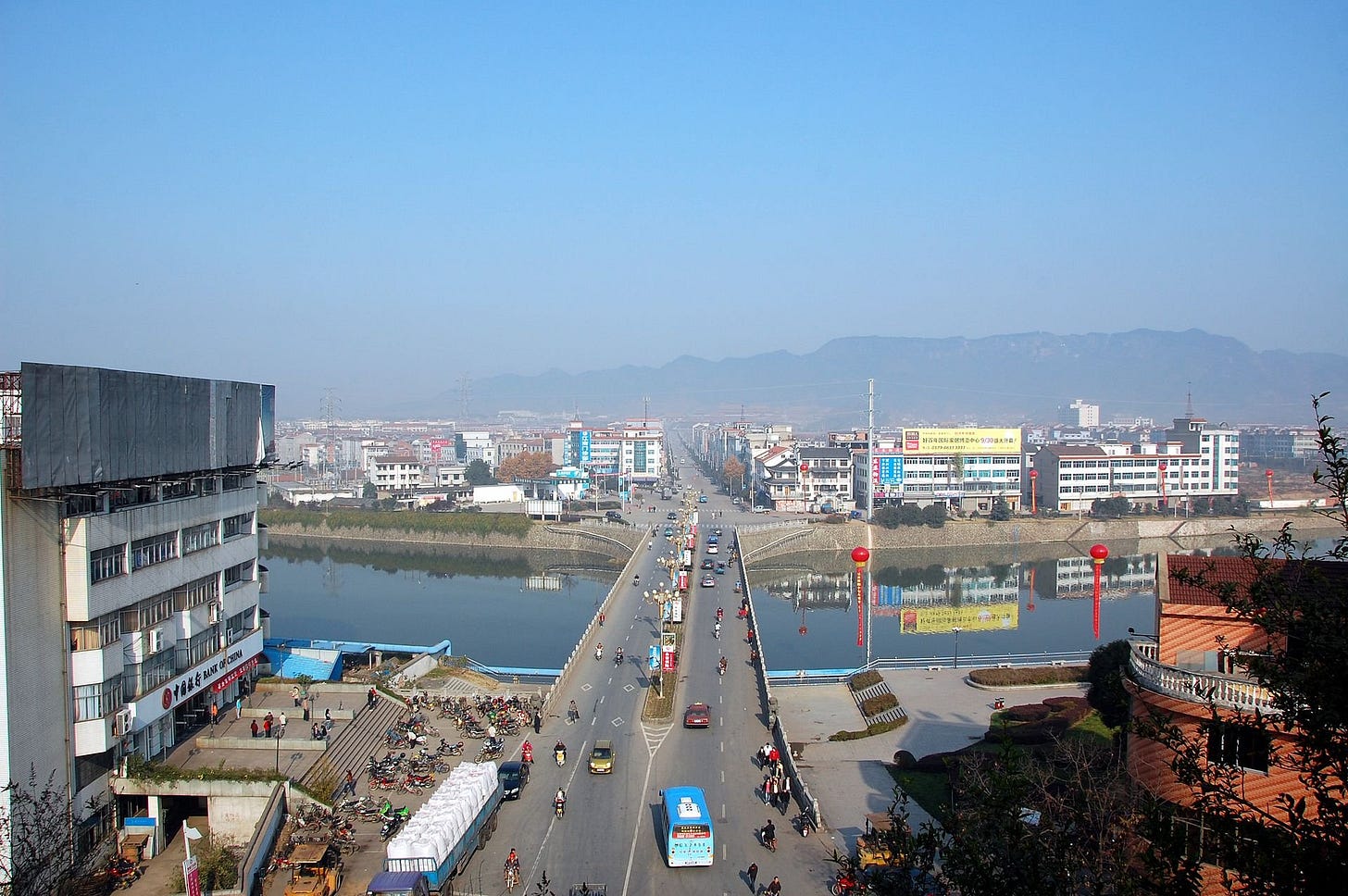
This less-than-objective stance has even seeped into the page of neighboring Taizhou, which notes that “The city’s people are reputed to be industrious and business-minded, although not to the same degree as neighboring Wenzhou [citation needed].”
Xuandi: That’s my hometown! And the reputation is actually true lol.
Joshua: So, why are these places home to millions of people usually covered worse than European cities that would barely qualify as big towns in China?
An obvious reason simply could be that Wikipedia is banned in China.
The Chinese language version was first, in 2015. For his 2016 master’s thesis, University of Oulu student Feiran Huang looked at Chinese Wikipedians who contribute to English articles. Several mention that the block contributed to their desire to contribute to English articles, rather than Chinese ones, due to the larger community around English Wikipedia.
It could be that the subsequent blocking of all Wikipedia versions in China in 2019 stymied the growth of a community who would be both motivated to write better Chinese regional articles and the language skills to actually discover the Chinese language sources needed to write fuller articles.
So why don’t local governments do something? Vast resources are dedicated to “telling China’s story well,” down to the local level. One of the articles that helped to kick off the recent smear campaign against Australia-based researcher Vicky Xu was apparently penned by a propaganda worker at a Chongqing prison.
And at least some inside the establishment recognize Wikipedia as an important platform. A BBC article from 2019 on “edit wars” on contentious mainland-Taiwan topics mentions pieces written by Chinese academics and publishing that call for the government to do more to boost China’s official point of view on the platform.
Many cities promote themselves in English, with many (especially in Shandong for unknown reasons) operating Twitter accounts of varying quality as depicted above in Krish’s “Bullshit Jobs in China” comic series. Weifang is a representative example, posting hundreds of tweets of banal landscapes with competently written English captions. But if you head to Wikipedia to learn more about Weifang, you’ll find lines that can only have been translated by a machine no more enthusiastic about its job than the city’s official tweeter. The local meat pie (肉火烧) is described as:
“Bite, coke dough rattling, in a high temperature furnace after repeatedly turning roast, pork moisten the green onion, egg, chopped dried shrimps fillings inside, aroma, mouth-watering produce the feeling, entrance juicy, full taste, people aftertaste.”
Though these pages are curiosities, they also represent a huge missed opportunity to address the huge knowledge deficit about China—try googling “Wuhan province” to see how many media outlets across the world fail to get the basic facts right in a way you’d never see with writing on the U.S.
That the only place to get English information about Hua County only mentions its population and a drunk driver’s death penalty means so much is out of sight—history, culture, roast chicken and even more weird stories.
While this information might be just a Google translate away, there’s no way to stumble across it while being sucked into a Wikipedia wormhole—you’d need to seek it out and have the knowledge needed to find it.
These pages are also probably a symptom of that knowledge deficit. It’s been argued that China isn’t a real place to Westerners—just a place to project fears and fantasies. This was clear in plenty of writing on the pandemic. Would better pages on Wikipedia change this? Probably not. But they’re a start—a truer reflection of the country’s massive diversity and relatable weirdness.

Yi-Ling: China’s Wikipedia pages seem to encapsulate the core problem with gathering English-language information in the country: those most equipped to do it, sadly cannot; those who can, are painfully ill-equipped. For that reason, I will continue to have to explain, in every English-language article that I write, that Sichuan Province, home to Deng Xiaoping and peppercorns, has a population roughly the size of France.
Jaime: It sounds like a lot of these small-town Wiki pages do mirror their counterparts—local government-built municipal history or cultural museums that are so useless in telling a story about the place, even though they might have cool artifacts, real information and knowledge often get lost in vagueness, grandiose language, or party-licking litanies. I want to think that it's not for the lack of knowledge or scholarship (in the case of history or archeology, surely many people are studying many things), but misplaced organization of knowledge.
Tianyu: Since the launch of Chinese Wikipedia in 2001, it’s been repeatedly blocked and unblocked by Chinese authorities until 2019, when it went behind the firewall in all languages. There used to be a very vibrant Chinese-speaking community on Wikipedia, dating back to the mid-2000s. Contributors from all over the Sinophone world had different politics. One Chinese Wikipedian wrote a letter to appeal to the Chinese government after it blocked the website for the first time in 2016, writing: “By blocking Wikipedia, we lose a chance to present China's voice to the world, allowing evil cults, Taiwan independence forces and others…to present a distorted image of China. We lose a chance to share academic knowledge with the world, and as users, a channel to gain information.” Edit wars over sovereignty and sensitive political issues were rampant, but it was important that difficult conversations existed and compromises were made. How did this self-governing community decide on editorial choices on polarized matters and deal with conflicts in a pre-“NMSL”/Milk Tea Alliance universe? (A testing ground for transnational Sinophone anarchism, maybe?)
It is also worth noting that China’s censorship of Wikipedia significantly discouraged unpaid contributors outside China from participating in the community. Domestic clones like Baidu Baike are nothing like Wikipedia—it is no secret that companies pay to produce and edit entries. (Baidu is notorious for amplifying false information at the advertiser's request while pretending it to be a community effort; it sold a medical discussion board to a private hospital, leading to the tragic death of a college student, Wei Zexi.)
Henry: Tianyu’s comment makes me wonder—why aren’t there more lulzy/satirical edits to English Wiki pages about China? Why nothing like the addition of Paul Ryan’s photo to an entry on invertebrates? Come on, evil cults, stop slacking!
[Quiz Answers: 1, 2, 3]
Tianyu: This article on senior fashion and Wikipedia entries is a stub.
You can help Chaoyang Trap by sharing your feedback, story ideas, and cute animal GIFs with us. Reach us by email (hello [at] chaoya.ng) or Twitter (@ChaoyangTrap).
Meanwhile, also consider upgrading to a paid subscription or forwarding us to a friend. All of our revenue will go towards paying contributors on time and supporting writers!
Krish: Next time: ~masculinity~, dating advice and the question: “What motivates those who don’t spiral into involuted stasis?”(Hint: it involves Jordan Peterson.)
Outro music this week is a mellow slice of Fuzhou-nese “leisure pop” (休闲流行) from Chaoyang Trap faves The 尺口MP. Yan and I profiled them back in 2018 and loved their scrappy lo-fi love letters to their scrappy lo-fi city. This new track is the lead single from their debut album, out today!
Tianyu: Bye!
Xuandi Wang is a writer who grew up in Zhejiang. His spiritual animal is Sufjan Stevens.
Joshua Dummer is a Beijing-based editor and meathead.
Jen Rao, aka drift & dune, is an illustrator and artist based in Beijing, and the co-founder and creative director of nugget records, a DIY cassette label and venue.
Yan Cong is a Beijing-based photographer, and one of the founders of Far & Near, a Substack about visual storytelling in China. You should subscribe!
Tianyu Fang is a writer who grew up in Beijing and is an avid collector of now-banned Jiang Zemin stickers.
Krish Raghav is a comic-book artist in Beijing. His Wikipedia bio would contain the section “Power Station Incident.”
Jaime (bot) is a critic and translator in Beijing who works in Chaoyang and has moved to Chaoyang. She is also a contributing editor at Spike.
Ting Lin is a writer in Beijing. She has very vivid nightmares about goldfish.
Yi-Ling Liu is a writer in Beijing. She paused climbing for a while b/c spinal health.
Henry Zhang is 30-going-on-75.






